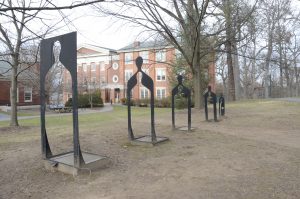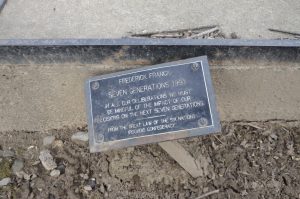Our Tuesday’s Objet series (pronounced “OB-JAY” from the French word for “object”) intends to highlight pieces on display outside the physical confines of our gallery spaces, to draw attention to the art that surrounds us on a daily basis.
My thin Florida skin still shrinks from the customary winter chill, but I was determined to explore a piece of public sculpture on campus this week. Seven Generations, by artist/writer Frederick Franck, can be found just off 7th street, between Kress Hall and the Career Development & Human Resources building. It is a series of 6 figural outlines in steel, graduating in size, and painted black. They are spaced so that, when looking at the sculpture head on, each figure visually encases the smaller figure behind it.


Dr. Frederick Sigfred Franck (April 12, 1909 – June 5, 2006), was a painter, sculptor, and author who was deeply passionate about human spirituality. He was born in The Netherlands, trained as a dental surgeon, and became a United States citizen in 1945. From 1958-1961, he operated a dental surgery office with the Nobel prize winning humanitarian Dr. Albert Schweitzer in West Africa. His sculptures are in the collections of the Museum of Modern Art, the Whitney Museum of American Art, the Fogg Art Museum, the Tokyo National Museum, and the Cathedral of St. John the Divine. Perhaps his most well known creation is the sculpture garden/park/meditative space adjacent to his home in Warwick, New York, called Pacem in Terris, which is Latin for “Peace on Earth.” Franck dedicated the park to Dr. Schweitzer, as well as to Pope John XXIII, and D.T. Suzuki, all of whom he valued as mentors. More than 70 of Franck’s works are exhibited there, and it is currently run by a non-profit foundation.

A small plaque at the base of the largest figure of Seven Generations reads, “In all our deliberations we must be mindful of the impact of decisions on the next seven generations – From the Great Law of the Six Nations Iriquois Confederacy.” Franck was inspired by the Constitution of the Iroquois Nations, part of which encourages a future-centric ethos, formatting it specifically within an environmental context. In a letter to the University, he wrote, “I am delighted that my Seven Generations will be on the Bucknell campus and that it may sharpen the awareness of students of our responsibilities to the generations to follow ours and to the earth itself. It may even last as proof to our successors, struggling with the tribulations we bequeath to them, that at the end of the twentieth century some of their predecessors were not unconcerned with this heritage.”[1] The piece’s dedication, in February 1992, was scheduled to occur in conjunction with a forum on the “Environmental Imperative,” initiated by then University President Gary Sojka.
Originally, the sculpture had 7 figures. The smallest was an image of a human fetus, affixed to the sixth section. Unfortunately, within a month of its dedication, the fetus figure and the explanatory plaque vanished. At the time, faculty members and students were upset, claiming the thefts as acts of violence against Native Americans. However, rumors circulated that the sculpture advocated a pro-life stance, and a series of university-wide debates ensued. Though eventually returned, both components would go missing again, and while the plaque remains, the image of the fetus does not.
Recently, the sculpture briefly came to our attention again; earlier this year persons unknown adorned the figures with pink pussy hats. They’ve since been removed (again by persons unknown), but it is interesting to note that this sculpture continues to be a stronghold for political and civic expression.
[1] Dr. Frederick Franck, letter to Dr. Robert Metzger, January 20, 1992.

